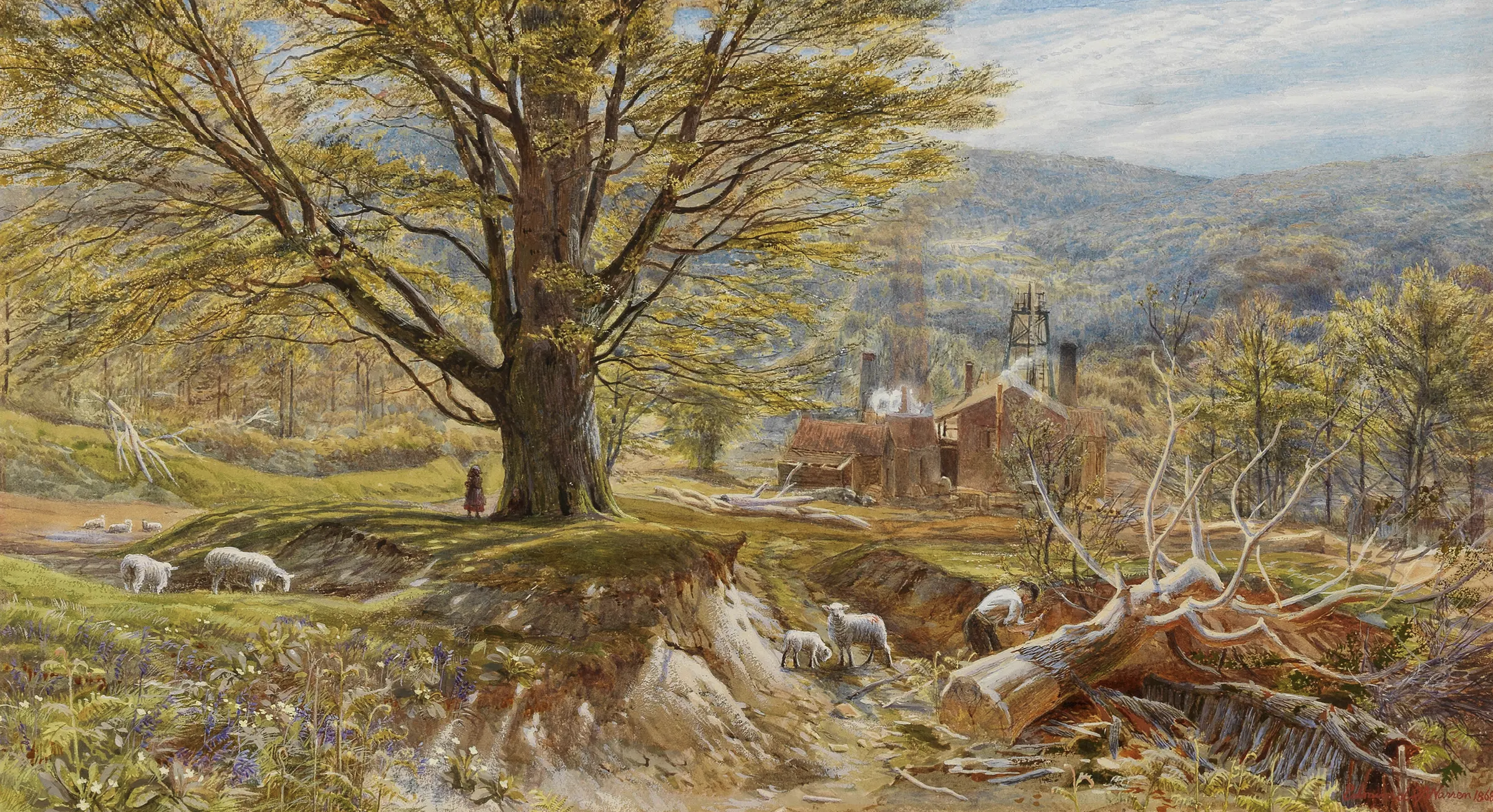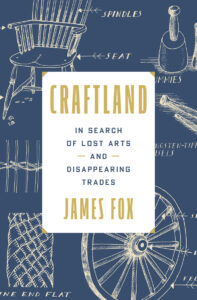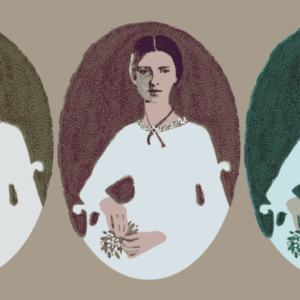
Rediscovering the Lost Arts of the English Woodlands
James Fox on the Thankless Job of the Chiltern Hills Woodsmen
If you had visited a typical English woodland a few hundred years ago, or at pretty much any point before then, you would have been ambushed by activity. The sounds of thudding axes, rasping saws, and ale-loosened conversation reverberated through the trees. Wagons trundled back and forth through the understory, past tents, toolsheds and piles of freshly cut timber.
If you had made it through to the glades at the center of the forest, you would have bumped into gangs of mud-smeared laborers—felling trees, sawing trunks, peeling bark, burning charcoal, turning utensils.
These men vanished from the underwood decades ago, but their legacy is very much still with us. If your surname is Barker, Cleaver, Collier, Forester, Hurst, Parker, Turner, Sawyer, Shaw, Underwood, or Woodward, there’s a good chance your ancestors once worked in or near the woods.
Most woodlands today are quiet, peaceful landscapes—places we go to escape work—but they are still marked by yesteryear’s trades. Lower your glance and adjust your focus and you may notice, for example, networks of shallow furrows wrinkling across the ground. They are called “hollow ways”—imprints left by carts and wheelbarrows to-ing and fro-ing through the centuries.
Most woodlands today are quiet, peaceful landscapes—places we go to escape work—but they are still marked by yesteryear’s trades.
Many woodlands are pocked by deeper depressions that once served as saw pits, where two sawyers (a “top dog” and an “underdog”) spent exhausting days cutting trees into timber by hand. You might also find the remains of abandoned charcoal hearths, lye pits, and quarries, all camouflaged by time and concealed by brambles. Many plants are themselves scarred by the history of human labor. If a tree kinks at right-angles just above the ground, it was probably once a hedgerow; if its trunk repeatedly swells into arthritic knuckles, it’s likely been subjected to pollarding.
For the best part of a thousand years—from at least the Norman Conquest to the Industrial Revolution—Britain’s woodlands were institutions: the factories of the pre-modern world. They built people’s homes, fueled their workshops and provided the raw materials for most manufactured items, including the vast naval fleets on which the country’s Empire came to depend.
They were managed by an army of highly skilled woodsmen operating all over the British Isles who cultivated and preserved these landscapes, creating balanced and sustainable ecosystems that benefited not one species but many. They did this not because they were environmentalists—the concept would have meant nothing to them—but because it was in their interests to do so: Their livelihoods, and those of their neighbors, depended on keeping these renewable resources intact.
The Chiltern Hills rise like a great green wave northwest of London, rolling through the counties of Bedfordshire, Hertfordshire, Buckinghamshire, and Oxfordshire until they’re stopped in their tracks by the River Thames. They cradle a classically English landscape of undulating fields, hedgerows and copse-crowned valleys, peppered with picturesque villages and neat market towns.
The Chilterns also happens to be one of the most forested places in England. Almost a quarter of the area is covered in woodland, 60 percent of which is “ancient” (defined as having been in continuous existence since 1600). Two hundred years ago, thousands of local men earned their living beneath the canopy, cutting timber and preparing firewood for London’s 1.4 million consumers. Now, however, only a few traditional woodsmen remain in these otherwise forsaken places.
One of them, based in the aptly named village of Woodcote in Oxfordshire, is so committed to the region’s trees, and so professionally dependent on them, that every year he participates in an ancient ritual in their honor. In the dark, desolate days of January he makes a series of journeys through the region’s fruit orchards, pours cider over frost-fringed roots, hangs toast on dormant branches, and proceeds to wake the trees from their slumber.
Face painted in ghoulish patterns, head crowned by pheasant feathers, he stomps through the orchards, banging pots, lighting fires, and chanting songs used for centuries to scare off winter spirits and solicit a bountiful harvest. “Drink to the bud and the blossom, drink to the root of the tree, drink to the fruit of the summer, Wassail! Let cider run free!”
“If people like me stop making them, the skills will be lost forever. I can’t allow that.”
Andrew Jarvis has spent all six decades of his life in the Chilterns, and knows its secrets as well as anyone. His elderly mother is one of the area’s last traditional lacemakers, continuing a local custom that dates back to the sixteenth century. Andrew’s woodland work takes him and his Jack Russell all over the region. Spend a decent length of time there and you’ll likely see his Land Rover rattling over the vales with a trailer full of timber. He provides landowners, farmers, and rural craftspeople with services that were once commonplace but are now rare to the point of extinction.
Andrew is, like Brian Wilson, one of Britain’s last makers of spars—the hazel pegs used by thatchers to affix materials to roofs. It is a monotonous and poorly remunerated business (he receives just fourteen pence for each carefully crafted spar), but he has no intention of giving it up: “If people like me stop making them, the skills will be lost forever. I can’t allow that.”
Andrew spends the winter season—officially from the end of September to the beginning of March, when the plants are dormant and the birds aren’t nesting—laying hedges in the fields and managing coppices in local woodlands. He is, as far as he knows, the last full-time, professional coppice-worker in the Chilterns.
Coppicing (the term is related to the French couper, “to cut”) is probably the oldest form of woodland management, believed to be in continuous operation throughout Europe since the Neolithic period. The practice involves the repeated felling of a tree back to a stump (called a stool) in order to stimulate a regrowth of shoots or poles that can then serve a variety of purposes.
Trees are cut at different intervals, depending on the species and the size of pole required. Willow is cut every year, beech and birch every three or four, hazel every six or seven, chestnut every fifteen to twenty, and oak and hornbeam every fifty.
In the past, most serious coppice-workers divided the underwood into sections (known variously as panels, cants, fells, coupes, sales, burrows, and haggs), each containing a range of species on different cycles, so guaranteeing a crop every year.
Every gardener knows that judicious pruning will revive and energize a plant, which can otherwise end up strangled by its own congested foliage. Much like pollarding (a similar practice but where cuts are made closer to a tree’s crown), coppicing significantly extends a plant’s lifespan. Britain’s oldest trees, some of them several thousand years old, have all reached such maturity as a direct result of regular trimming.
“Realistically I’ll only see one or two more crops in my lifetime, and there’s no one to follow me. All this effort will probably come to nothing.”
Coppicing doesn’t simply benefit the plant in question. Much like dry stone walling, it produces a wide, rich ecosystem. The clearing process draws sunlight into the forest’s penumbral depths, triggering an explosion of plant life in the spring and summer, which in turn provides valuable habitats (often more diverse than those found in “natural” woodlands) for small mammals, birds, and pollinating insects. One of them, the heath fritillary butterfly, is so wedded to these outdoor workshops that it’s nicknamed the “woodsman’s follower.”
Most English woodlands used to contain some form of coppice, often alongside larger trees (called “standards”) grown for timber. Coppiced material served a range of purposes, being fashioned into baskets, brooms, fences, firewood, tool handles, walking sticks, tanning bark, and the wattle beneath every bit of daub.
But as the demand for wooden wares fell away, the country’s copses—many of which had been managed continuously for more than a thousand years—were ripped out or quietly abandoned.
Since the beginning of the 20th century 90 percent of Britain’s actively coppiced woodlands have vanished, many replaced by vast monocultural grids of conifers. This has damaged not just the profession that cultivated them but the species that depended on them. The last few decades have seen dramatic declines in the numbers of nightingales, dormice, and butterflies, all of which thrive in the underwood. The “woodsman’s follower” would already be extinct in this country had conservationists not intervened to save it.
It is late January—a week after the last wassail—and Andrew is working in a secluded valley at the southern edge of the Chilterns. He parks in a muddy turnout and carries his tools into a sloping beech forest. The mature trees rise around him like columns then vault together into a tessellated canopy, creating a space so resonant that even a tiny wren seems to be wielding a trumpet. Andrew wades through drifts of dead leaves that for a few enchanted weeks in spring will vanish beneath bluebells. Beyond the wood, on a terraced bank, lies a large copse of hazel. Hundreds of stools explode out of the wet ground in silvery stems.
Despite appearances, this patch of underwood is a ruin. It was orphaned a lifetime ago, untouched since the Second World War. Most of the stools are “overstood” or “derelict” (terms used to describe a coppice that has fallen out of rotation and grown into so-called “high forest”). Andrew spent four years persuading the owners and their skeptical gamekeeper to let him bring this once productive plot of land back into rotation.
But he recognizes that woodland management can be an unappealingly long-term commitment: “These stools will next need to be cut in six or seven years, by which time I’ll be in my sixties,” Andrew says. “Realistically I’ll only see one or two more crops in my lifetime, and there’s no one to follow me. All this effort will probably come to nothing.”
”This woodland, like so many ancient woods around the country, hasn’t survived because we left it alone. It’s survived because we managed it, coppiced it, thinned it—because we used it.”
Andrew moves through the milky winter light, stepping over beer bottles left by the last men to work this land. He coppices each tree close to the ground with clean, angled cuts, ducking and swerving as branches tumble around him. He assesses the crop as he goes. “Rubbish!” he shouts, throwing a dog-legged pole aside. Then “Oooh, that’s dreamy that is!” brandishing a dead-straight branch like a trophy.
He removes the spidery tops of the trees and lays them back over the stools to protect the coming shoots from browsing deer, then sorts and processes the rest of the hazel. He cuts thicker, straighter poles to a length of about 5 feet and 5 inches (the distance between his outstretched hands) and longer, slimmer ones to around 10 feet, trims them with an old billhook, places them on separate piles, and ties them into bundles of ten and twelve respectively.
Both are destined for a local hedge-layer. The shorter poles will become stakes, driven into the ground along the full length of the hedgerow; the longer ones will become binders, woven horizontally between the stakes. Together they’ll form the scaffolding around which various plant species will grow into a stock-proof barrier. Andrew receives just £1.30 for each item, so he needs at least two hundred to make the day worthwhile. He works from dawn till dusk, pausing only for a flask of tea and a rectangle of leftover Christmas cake.
Woodsmen like Andrew used to be an important cog in the machine of British society, as essential to our predecessors as plumbers and delivery drivers are to us. Before industrialization, globalization, and of course plastic, most manufacturing materials came not from foreign factories but local forests.
Woodland management wasn’t just a valuable craft in its own right but the wellspring of all the others. It supplied blacksmiths with their firewood, coopers with their stakes, tanners with their bark, wheelwrights with their timber, and basket-makers with their willow. Without the workers of the woods, few of those crafts would have been viable. And yet even now, in a society that values forests and is committed to expanding them, the trade is overlooked.
“There’s all this talk nowadays of rewilding,” Andrew sighs. “It’s a lovely idea, don’t get me wrong. But it’s often based on a misunderstanding. This woodland, like so many ancient woods around the country, hasn’t survived because we left it alone. It’s survived because we managed it, coppiced it, thinned it—because we used it. If everything becomes rewilded, species will become completely overwhelmed by other species and die out. By managing our woodlands, you’re allowing different plants and animals to live in harmony with each other, and not be swallowed up by bramble and gorse.”
He takes a final bite of his Christmas cake and gestures around him. “This landscape has been cultivated for thousands of years specifically for us to be able to live and work on it. If we want to continue doing that, which surely we do, we need to relearn the art of woodland management.”
__________________________________

From Craftland: In Search of Lost Arts and Disappearing Trades by James Fox. Copyright © 2025 by James Fox. Published in the United States by Crown, an imprint of the Crown Publishing Group, a division of Penguin Random House LLC.
James Fox
James Fox is Director of Studies in History of Art at Emmanuel College, University of Cambridge, and a BAFTA-nominated broadcaster. His many acclaimed BBC television documentaries include programs about British art, Japanese culture, and an enduringly popular history of color in art. The World According to Color is his first book for a trade audience.












